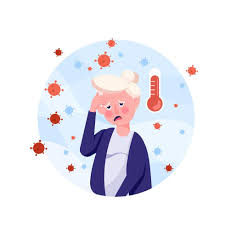Blunt or absent fever response in Older population! here's Why
Fever in elderly individuals can be more concerning than in younger adults.Reason being a phenomenon known as Immunosenescence. It is the gradual deterioration of the immune system associated with aging. It affects both the innate and adaptive branches of immunity and contributes to increased susceptibility to infections, poorer vaccine responses, chronic inflammation, and a higher risk of autoimmune diseases and cancer in older adults.
In other words, it may present as blunt or absent fever overlooking the foci of the infection and missing it out completely. Over the years and traditionally, onset of fever alerts of an infection foci by default. But imagine if this alerting symptom does not show up in an older adult. Let's walk you through this interesting aspect of ageing. For Simple understanding
What Counts as a Fever in the Elderly?
- Normal body temperature tends to be lower in older adults.
- A fever is typically defined as:
- Oral temperature ≥ 100°F (37.8°C)
- Persistent oral temperature ≥ 99°F (37.2°C)
- Increase of ≥ 2°F (1.1°C) above baseline
Common Causes of Fever in the Elderly
- Infections – Most common cause, including:
- Urinary tract infections (UTIs)
- Pneumonia
- Skin infections (cellulitis, pressure ulcers)
- Gastrointestinal infections
- Sepsis (bloodstream infection)
- Non-Infectious Causes
- Medication reactions - drug fever - phenytoin sulfa drugs, beta lactams, cytostatics and so on.
- Autoimmune diseases (e.g., rheumatoid arthritis, giant cell arteritis)
- Cancer ( lymphoma, leukemia)
- Heat exhaustion or heat stroke.
Salient Features of Immunosenescence:
- Adaptive Immune Changes:
- T cells: Reduced production of naïve T cells (especially due to thymic involution), accumulation of memory and senescent T cells, reduced T cell receptor diversity.
- B cells: Decreased generation of new B cells in bone marrow, reduced antibody production and affinity, impaired class-switching.
- Innate Immune Changes:
- Macrophages & neutrophils: Less effective phagocytosis and signaling.
- Dendritic cells: Reduced antigen presentation ability.
- Natural killer (NK) cells: Altered cytotoxicity, though numbers may increase.
- Inflammaging:
- A chronic, low-grade inflammation commonly seen in aging individuals, contributing to tissue damage and disease.
- Impaired Vaccination Response:
- Older adults often have a reduced immune response to vaccines due to impaired T and B cell function.
As we age the physiological changes responsible for Immunosenescence are as follow:
- Thymic involution (shrinkage of the thymus gland)
- Chronic antigenic stimulation (e.g. from latent infections like CMV)
- Accumulation of DNA damage
- Mitochondrial dysfunction
- Changes in the gut microbiome (Dysbiosis).
Summarily, Medical Attention to be sought when fever is accompanied by:
- Confusion, delirium, or altered mental state.
- Severe weakness or inability to move.
- Shortness of breath or chest pain.
- Persistent vomiting or dehydration signs.
- Rapid heart rate or low blood pressure.
Home Care Tips for home care
Stay hydrated with water, broth, or electrolyte drinks.
Rest and monitor temperature regularly.
Use fever reducers as recommended by a doctor.
Apply cool compresses if needed.
Mitigation through
Healthy lifestyle: Regular exercise, balanced diet, stress management
Vaccination: vaccines for older adults
Senolytics: Experimental drugs targeting senescent cells
Immune rejuvenation therapies: Ongoing research in stem cells, thymic regrowth, etc.
Dr Akshat Khandekar
Family and Geriatric medicine
Bhopal
